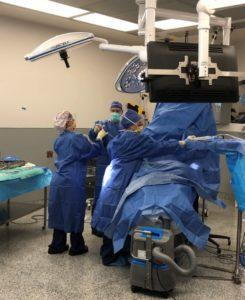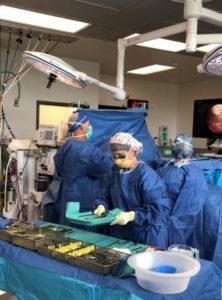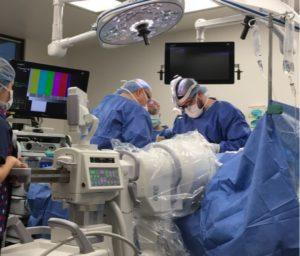What does it look like inside the sterile surgical suite?
- posted: Jan. 18, 2022
Left: Proper transition of the surgical team from non-sterile to the sterile surgical suite needs to be seamless. A non-sterile team member is tying the surgeon’s sterile gown (sterile zone in the front) while the Certified Surgical Technologist (CST), already dressed in the sterile gown, provides sterile gloves to the surgeon. The sterile surgical team double glove to help ensure the sterile field is maintained throughout the surgery.
The non-sterile Circulating Nurse is the patient advocate (the patients eyes and ears) while the patient is under anesthesia. They work with the surgeon and anesthesiologist before and during surgery to ensure patient safety and well-being. They bring the patient into the surgical suite and are dedicated to making sure all the patient’s needs are being met until the patient is back in the post-op recovery room. They are responsible for the operating room record, documenting implants, and they collaborate with the CST to ensure all instruments and supplies are accounted for following surgery.
The CST is a crucial member of the surgical team. They prepare the surgical field with instruments, implants, and supplies before surgery. The CST is always aware of the sterile field, watching to make sure that sterility is maintained at all times.
 Right: Everything that is draped in blue is considered sterile and can only be touched by the sterile team members. If additional items or implants are needed during surgery, the Circulating Nurse will open these items in a special way to avoid contamination and carefully pass to the CST or the sterile field.
Right: Everything that is draped in blue is considered sterile and can only be touched by the sterile team members. If additional items or implants are needed during surgery, the Circulating Nurse will open these items in a special way to avoid contamination and carefully pass to the CST or the sterile field.
Right: This device at the end of the bed is called a “Bair Hugger”. It is a warming device to keep the patient warm during the surgery. The Circulating Nurse and Anesthesiologist are always checking on the patient under the sterile drape during the surgery.
 Left: The surgeon will often have a first CST that will prepare the sterile field and pass them instruments. A second CST or a Physician Assistant (PA) is frequently used as a second set of hands to maintain patient position, hold the arthroscopic tools in place, and retract the site so the surgeon can better visualize the anatomy during surgery.
Left: The surgeon will often have a first CST that will prepare the sterile field and pass them instruments. A second CST or a Physician Assistant (PA) is frequently used as a second set of hands to maintain patient position, hold the arthroscopic tools in place, and retract the site so the surgeon can better visualize the anatomy during surgery.
During this arthroscopic procedure, Dr. Price, is using minimally invasive surgical tools at the surgical site, while watching what is happening inside the joint on the monitor. The CST anticipates what the surgeon will need next and have it ready before they even need to ask.
The CST works with the implant vendors before surgery to have access to all instrument sets needed to successfully complete that surgery. This sterile preparation is done ahead of time.
Below: In this photo you can see the non-sterile Radiologic Technologist with the C-arm that has a sterile drape over the end. The C-arm provides imaging in real time during surgery to guide the surgeon. The technologist moves the C-arm machine in and out of the sterile field as needed. Dr. Witte is the surgeon in this photo, and can view any images he needs on the monitors, without compromising the sterile environment.

The post What does it look like inside the sterile surgical suite? appeared first on Missoula Bone & Joint.
